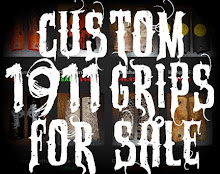Here is another installment of my "Brief History" series. This time, it's all about the sport of Trap Shooting!
Early this year, my brother & I took up this addicting sport. We are avid shooters and we've been shooting all sorts of guns since we were kids. As military brats, we "played" with our dad's army-issued Colt M1911. As kids, we used to shoot birds with our competition CO2 air rifle. Over the years, we continued to pursue our hobby, but mostly we only did target shooting & a little practical shooting. I like shooting pistols, fell in love with the iconic 1911, while my brother became more interested in rifles like the AR-15. Let's just say that we have quite an arsenal between the two of us. We make it a point to go to the range to sharpen our skills at least once a month. We live in the same city & fortunately, there is an outdoor rifle/pistol & trap range just 20 minutes from where we live.

In one of our trips to this facility, we stopped by the trap range to check it out. We've always been curious about trap shooting but never really tried it. It looked fun so we tried it out with a loaner shotgun. From then on, we were hooked! We bought our "starter" shotgun, a Stoeger over/under competition shotgun. In only my third try, I shot 23 out of 25! Boy, all these years of target shooting does seem to pay off!
Now, what is the history of trap shooting, you ask? Well according to Dick Baldwin (www.traphof.org), it has a long & colorful history that goes back to late 18th century England. It was the sport of the aristocrats of the time. The sport was first mentioned in a British publication called "Sporting Magazine" in 1793. Here is an excerpt:
"The great celebrity of this sport, in which some of the first shots in England are so frequently engaged, encourages us to communicate an account of its fashionable influence and increasing prevalence as a subject applicably entitled to a place in our sporting receptacle." (Say whaaaat?!?)
During those days, live pigeons were used as targets. They were released from cages, called traps. Until now, the modern clay targets are still called "pigeons" and the contraption that launches them is still called a "trap". This sport came to the American continent in the early 1800s. One of the first contests was held in 1831 at the Sportsmen's Club in Cincinnati, OH, where they used passenger pigeons & sparrows. These birds were quite abundant then. During around the Civil War, the practice of using live birds was replaced by targets. These early targets varied from metal ones with rotating wings to the more popular glass ball filled with feathers. They were usually launched by catapults.

The first clay targets were introduced in the 1880s by George Ligowskey. They were first used in the New York State Shoot, a state-wide shooting event, at Coney Island. They became an instant success. In 1884, Fred Kimble invented a composite clay target that "explodes" into the puff of smoke that we see today.
The first trapshooting club, called the American Shooting Association, was organized in 1890. They were responsible for producing the sport's first rule book. In 1892, they changed the name of the organization to The Interstate Association, and evolved into an organization made up of gun & powder manufacturers. Again, in 1919, the organization was renamed American Trapshooting Association (ATA). In 1911, for the fist time, doubles targets were introduced. From 1915-19, for the first time, a group called the American Amateur Trapshooting Association (AATA) was organized by amateurs. It co-existed with the ATA for a few years. Finally in 1923, one of the the current governing bodies, the Amateur Trapshooting Association (also ATA) was organized to replace the old ATA.
The sport currently has two independent governing bodies, the modern ATA, which sanctions shoots throughout the US & Canada, and the Pacific International Trapshooting Association (PITA), which sanctions shoots in the West Coast.
Take it from me... Nothing beats shooting a flying object to smithereens! This sport takes a lot of concentration, you only get better with age. I wish that I discovered this sport earlier...
Back to HOMEPAGE
.
 The "comic book" features the highlights of his life & his amazing inventions. I found this 45-page document on m1911.org (thanks John C.!). It's interesting that it didn't mention the greatest handgun in the world (it's the 1911 of course, Geeez!). There is also no mention of the publisher nor the year of publication. The document seems to be promoting the FN & Browning companies (maybe that's why the Colt 1911 was not mentioned), but it's still a great read for those who are fascinated by this great American legend!
The "comic book" features the highlights of his life & his amazing inventions. I found this 45-page document on m1911.org (thanks John C.!). It's interesting that it didn't mention the greatest handgun in the world (it's the 1911 of course, Geeez!). There is also no mention of the publisher nor the year of publication. The document seems to be promoting the FN & Browning companies (maybe that's why the Colt 1911 was not mentioned), but it's still a great read for those who are fascinated by this great American legend!
















